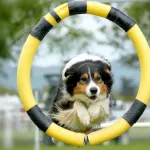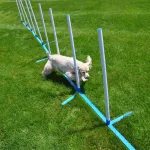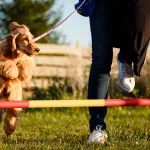Training tips
The Importance of Training Reinforcement for Long-Term Dog Training Success

Training your dog is not a one-time event—it's a lifelong journey. Just like humans need regular practice to maintain skills, dogs need consistent reinforcement of their training to retain what they've learned and to develop good behavior patterns. At Calidognia, we understand the vital role that training reinforcement plays in every dog's learning process.
When it comes to raising a well-behaved, confident, and happy dog, consistent dog training and ongoing training reinforcement are absolutely essential. Training your dog is not a one-time event—it's a lifelong journey. Just like humans need regular practice to maintain skills, dogs need consistent reinforcement of their training to retain what they've learned and to develop good behavior patterns.
At Calidognia, we understand the vital role that training reinforcement plays in every dog's learning process. Whether you're teaching basic obedience, addressing behavior issues, or preparing your pup for advanced skills, reinforcing training at home and during daily life is key to success. In this blog, we will explore why dog training reinforcement matters, how to implement it effectively, and how services like pet sitting can support your dog's ongoing learning.
By the end of this guide, you'll have actionable strategies to help your furry friend become the best version of themselves—and you’ll know when to reach out to a professional like Calidognia for guidance. And if you’re ready to take the next step, don’t hesitate to contact us!
What Is Training Reinforcement?
Training reinforcement refers to the practice of consistently rewarding or encouraging desired behaviors in your dog after the initial training period. While initial dog training typically involves introducing commands and shaping behaviors, reinforcement is about maintaining those behaviors over time.
Reinforcement helps your dog understand that good behaviors bring positive outcomes. Without regular reinforcement, dogs may become confused or forget commands, especially if their environment or routine changes.
In short, training reinforcement ensures that the lessons your dog learns during their dog training sessions become lasting habits rather than temporary tricks.
Why Is Training Reinforcement Important?
- Maintains Learned Behaviors: Even the best-trained dogs need practice to retain their skills. Without consistent training reinforcement, behaviors such as sit, stay, come, and leash walking can deteriorate over time. Reinforcement strengthens the neural pathways associated with these behaviors, making them second nature to your dog.
- Builds Confidence: Regular dog training and reinforcement build your dog’s confidence. Knowing what is expected of them and receiving positive feedback helps your dog feel secure and comfortable in different situations. Confident dogs are less likely to exhibit fear-based or reactive behaviors.
- Strengthens the Bond Between You and Your Dog: Engaging in training reinforcement strengthens the relationship between you and your dog. When you spend time training and rewarding your dog, you build trust and create positive associations with you as their leader.
- Encourages Lifelong Learning: Dogs are naturally curious and love to learn. Incorporating training reinforcement into your daily routine keeps your dog mentally stimulated and helps prevent boredom-related behaviors such as chewing or excessive barking.
- Supports Behavior Maintenance During Changes: Life changes—such as moving to a new home, adding a family member, or changing your work schedule—can disrupt your dog’s routine. Consistent training reinforcement helps your dog adjust to new situations while maintaining their good behavior.
How to Effectively Reinforce Training at Home
Training reinforcement should be a natural part of your everyday interactions with your dog. Here are some practical tips to ensure you're reinforcing training effectively:
- Use Positive Reinforcement: Positive reinforcement—rewarding desired behavior with treats, praise, play, or affection—is one of the most effective dog training techniques. When your dog performs a behavior you like, immediately reward them to strengthen the behavior.
- Keep It Consistent: Consistency is key in training reinforcement. Make sure everyone in your household uses the same cues, expectations, and reward system. Mixed messages can confuse your dog and slow their learning progress.
- Practice Short Sessions Frequently: Dogs learn best with short, frequent training sessions. Incorporate 5-10 minute training reinforcement sessions into your daily routine. For example, practice a quick round of sit-stay-come before meals or during walks.
- Generalize Behaviors: Practice commands in various environments and situations. A dog who can sit on command in the kitchen should also be able to sit in a park or at the vet’s office. Generalization ensures that behaviors are reliable no matter the context.
- Use Life Rewards: Not all reinforcement needs to involve treats. Life rewards—such as opening the door to go outside or playing with a favorite toy—can be powerful motivators. Teach your dog that polite behavior leads to enjoyable outcomes.
- Monitor Progress and Adjust: Regularly evaluate your dog’s progress and adjust your training reinforcement as needed. If your dog seems to be forgetting a behavior, increase the frequency of practice. If a behavior is well established, you can gradually reduce the use of treats while continuing verbal praise.
Common Mistakes to Avoid in Training Reinforcement
Even well-meaning dog owners can unintentionally undermine their dog training efforts. Here are some common pitfalls to watch out for:
- Inconsistency: If you sometimes reward a behavior and sometimes ignore it, your dog may become confused about what is expected. Be consistent with your training reinforcement to ensure clear communication.
- Unintended Reinforcement of Undesired Behaviors: Be mindful of what behaviors you’re reinforcing. For example, if you give your dog attention when they jump on you, you’re reinforcing jumping. Instead, reward calm behavior.
- Lack of Variety: Using the same reward every time can cause your dog to lose interest. Mix up your training reinforcement with different treats, toys, and forms of praise to keep your dog engaged.
- Neglecting Reinforcement Over Time: It’s easy to relax on training reinforcement once your dog seems to have mastered a behavior. However, regular reinforcement—even if less frequent—is important to maintain skills over time.
How Pet Sitting Services Can Support Training Reinforcement
Many dog owners rely on pet sitting services when they travel or have busy schedules. The right pet sitting professional can play a vital role in maintaining your dog’s training and routines while you’re away.
Here’s how pet sitting supports training reinforcement:
- Consistency During Your Absence: A professional pet sitter from Calidognia will follow your training guidelines, ensuring your dog’s behaviors remain consistent even when you’re not home. This prevents regression and helps your dog feel secure.
- Routine Maintenance: Dogs thrive on routine. A good pet sitting service will maintain your dog’s daily schedule, including mealtimes, walks, potty breaks, and training reinforcement sessions.
- Mental and Physical Stimulation: A skilled pet sitter can incorporate dog training games and exercises into their time with your dog, providing both mental and physical stimulation. This reduces boredom and keeps your dog engaged.
- Customized Care: At Calidognia, our pet sitting services are tailored to your dog’s specific needs. Whether your dog is working on basic manners or advanced tricks, we provide personalized training reinforcement as part of our care.
The Role of Professional Dog Trainers in Training Reinforcement
While daily training reinforcement at home is essential, working with a professional dog training service like Calidognia can elevate your dog’s skills and help you address challenges more effectively.
- Expert Guidance: Our experienced trainers understand how to adapt training reinforcement techniques to suit your dog’s personality, learning style, and behavior goals.
- Problem-Solving: If you encounter difficulties—such as stubborn behaviors or regression—our trainers can troubleshoot and provide customized solutions.
- Advanced Skills Development: Beyond basic obedience, Calidognia can help you teach your dog advanced skills and fun tricks, adding variety and enrichment to your dog’s life.
- Support for All Life Stages: From puppies to senior dogs, our dog training programs and training reinforcement services are designed to support your dog through every stage of life.
How to Incorporate Training Reinforcement Into Pet Sitting Services
When choosing a pet sitting provider, ask about their experience with dog training and training reinforcement. Here are some tips for a successful partnership:
- Provide a training plan: Share your dog’s current commands and behaviors with your pet sitter.
- Communicate clearly: Explain your preferred reinforcement methods and any behaviors you want to discourage.
- Request updates: Ask your pet sitter to provide regular feedback on your dog’s training progress during their care.
- Choose professionals: Select a pet sitting service like Calidognia that values consistent, positive training reinforcement.
Dog training is not a one-time event—it’s an ongoing process that requires patience, consistency, and love. Training reinforcement is the key to helping your dog retain skills, build confidence, and thrive in all areas of life.
Whether you’re practicing at home, working with a professional trainer, or using pet sitting services, regular reinforcement of good behaviors ensures long-term success.
At Calidognia, we are passionate about helping dogs and their families achieve lasting training results. Our expert dog training, training reinforcement, and pet sitting services are designed to support your dog’s learning and well-being every step of the way.
If you’re ready to strengthen your dog’s training and create a positive learning environment, don’t hesitate to contact us today! We’d love to help you and your furry friend on your training journey.




